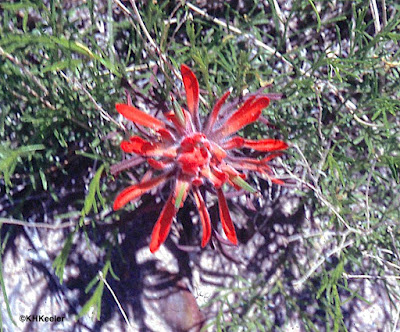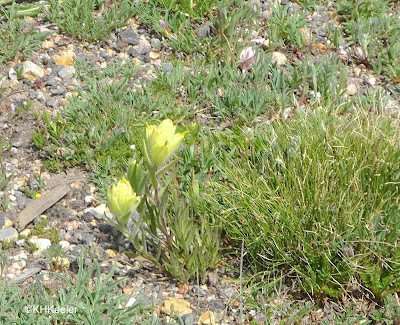They're a splash of orange on the mountainside or of red in the meadow: Indian paintbrushes. Also called flame flower, prairie-fire, squaw feather, and painted cups, the Castilleja species, now classified in the owl clover family, Orobanchaceae, but long considered figworts, Scrophulariaceae, are handsome wildflowers.
 |
| Indian paintbrush, Castilleja, in western Wyoming |
There are a lot species of Indian paintbrush--160 in North America!--all but a couple native to the western half of the continent (view USDA plants species maps and marvel link. See the diversity of the flowers in the Wikipedia article link). North America has most of this genus, although a few species migrated to Eurasia and South America. The USDA gives the common name owl's clover to two species, calls one johnny nip and another cream sacs for another species of Castilleja, but all the rest are called some version of Indian paintbrush. The flowers are green, but surrounded by bright bracts (modified leaves) that make the plants so colorful and visible. The bracts can be any shade from white through yellow and orange to red. Presumably the name paintbrush refers both the variety of colors and the shape of the flower head.
 |
| If you look carefully you can see the green flowers amid the red bracts. |
There is a Native American story, retold by Tomie dePaola as lovely picturebook, that recounts a legend of the origin of Indian paintbrush plants, a story told by a number of North American tribes. The book tells of a boy, Little Gopher, who was too small to do well at hunting or fighting, and was comforted by a dream vision that instructed him to pursue his talent for art. As he grew, he recorded the tribe's history in beautiful paintings. He gathered rocks and plants to make his colors, but always wished for brighter ones. In particular, he wanted to paint the brilliant colors of the sunset. Then a dream vision, praising his art's contribution to his people, sent him up his favorite hill at sunset. Scattered in the grass were brushes full of bright paint. Hurriedly, skillfully, he painted the sunset, casting aside the brushes as he finished in his haste to capture the fleeting colors. In the twilight he returned to the village to show them his painting, a masterpiece of color. In the morning, the hill was ablaze in color, because the discarded brushes had taken root and turned into flowers, colored yellow and red and orange. Every spring from that time, the hills and meadows burst into bloom with Little Gopher's paintbrushes.
 |
| Indian paintbrush from central Colorado mountains |
The scientific name, Castilleja honors Domingo Castillejo (1744-1786), professor of botany at the Royal Naval College of Surgery, Cadiz, Spain, to whom many plant collections from the Americas were sent.
The Indian paintbrushes are small, herbaceous plants, generally perennial. They produce their bright floral displays in high summer and later release tiny, dustlike seeds into the wind. You can buy Indian paintbrush seeds, but you rarely find the plants in gardens. They are difficult to grow because they are hemi-parasites. Fully parasitic plants (holoparasites) have pale or orange leaves, not green, and get all their sustinence from other plants. Hemiparasites like Indian paintbrushes do some photosynthesis and have green leaves, but also tap the roots of other plants and feed off their neighbors. The story is complicated by the fact that Indian paintbrushes are facultative, not obligate, hemiparasites. That is, they can grow successfully without a host. Seeds will germinate, grow, and flower without a host, but they grow better and faster when they can attach to a host. (Some species do extremely poorly without being attached to a host and others have not been studied.) They can be cultivated but providing suitable hosts is important for success. Not surprisingly, they don't transplant well.
Plant chemistry is sufficiently complex that you would expect plant parasites to specialize and where it has been studied, some plants make much better hosts than others. Colorado and Wyoming Indian paintbrushes are likely to be found parasitizing of sagebrushes (genus Artemisia), which are abundant in Western North America. Elsewhere, Indian paintbrushes parasitize grasses (many species) and lupines (Lupinus app.), sedges (Carex spp.), native roses (Rosa sp.), wild buckwheats (Eriogonum sp.), and probably others. Wildflower websites suggest putting your Indian paintbrush seeds next to grasses, such as blue grama (Bouteloua gracilis) and buffalo grass (Bouteloua dactyloides), so the grasses can be host plants. Experimental studies found they grew well parasitizing chrysanthemums (Chrysanthemum spp.) and yarrow (Achillea millefolium). For many Indian paintbrush species, host preferences are unknown.
 |
| tundra paintbrush, Castilleja occidentalis |
The bright flowers are pollinated by a wide array of insects, including bumblebees, hummingbirds, flies, and hoverflies. When two species of Indian paintbrush grow close to each others, they often hybridize, so it addition to 160 species growing across North America, there are an unknown number of intermediates, especially in the western U.S. If the plant you find doesn't fit the descriptions in the book, it is likely a hybrid.
Native Americans used various species of Indian paintbrush for as medicines, such as treating spider bites or burns, but they also had diverse nonmedical uses for them. Children sucked the flowers for their nectar, and lovers slipped a bit onto their desired's clothing as a love charm. Pieces put into shoes reduced smelly feet. Covered in slug slime, several tribes used them to capture hummingbirds. Women and girls wore Indian paintbrushes in their hair or carried them in ceremonies such as the harvest dance. The Paiute warned that touching the scarlet Indian paintbrush would cause a dangerous storm.
 |
| Indian paintbrushes, central Colorado Some are more pink than red (click on photo) |
The scarlet Indian paintbrush, also called the Wyoming Indian paintbrush, Castilleja linariifolia, is the state flower of Wyoming.
Indian paintbrushes are beautiful native American wildflowers. Their great diversity, abundance, and broad range suggest that being a hemiparasite is a successful "life style," despite the fact that failure of gardeners to easily grow them makes them seem finicky. And there is a special joy in seeing a plant in nature that isn't growing in all the neighbors' gardens. Watch for them!
 |
| Indian paintbrush seen in Colorado, probably the sulphur Indian paintbrush Castilleja sulphurea |
Comments and corrections welcome.
References
Adler, L. S. 2003; Host species affects herbivory, pollination and reproduction in experiments with parasitic Castilleja. Ecology. 84 (8): 2083-2091 link Accessed 11/13/2020.
Darrow, K. 2006. Wild About Wildflowers. 2nd ed. WildKat Publishing Company, Glendale, AZ.
dePaola, T. 1988. The Legend of the Indian Paintbrush. Putnam and Grosset, New York NY. See it on YouTube link Accessed 11/14/2020.
Hersch, E. I. and B. A. Roy. 2007. Context-dependent pollination behavior: an explanation for patterns of hybridization among three species of Indian paintbrush. Evolution. 61 (1): 111-124. Online: link Accessed 11/14/2020. Scroll down for neat color photo!
Moerman, D. E. 1997. Native American Ethnobotany. Timber Press, Portland, OR.
Schmidt, N. R. 2018.Parasitic plants and community composition: how Castilleja levisecta affects and is affected by its community. Ph.D. Thesis, University of Washington, Seattle WA link Accessed 11/13/2020
Kathy Keeler, A Wandering Botanist
More at awanderingbotanist.com
Join me on Facebook: https://www.facebook.com/AWanderingBotanist
What beautiful information about a common but extraordinary plant! Thank you for this post. Question: I have noticed that as I go up in altitude in Colorado and California from say 8,000 to 13,000+, the colors of paintbrush and columbine seem to parallel each other. I have wondered what factors caused them to have a similar palette at the same altitudes; whether temperatures, or soils, or snow cover, length of growing season, etc. Hearing from you that the paintbrush are hemiparasitic, gives me a new hypothesis: that the paintbrush are parasitizing the columbines, and somehow drawing their colors from the columbine. Any thoughts?
ReplyDeleteChanges in flower color are most often due to change in pollinators. Red-flowered columbines are hummingbird pollinated, yellow ones pollinated by bees and moths, for example. My first guess is that colors that work to attract pollinators for the columbine work for the paintbrush growing in the same habitat (convergence). The color molecules generally are confined to the flowers and paintbrush attaches to plant roots, so it would be difficult to steal color molecules that way. Its a neat observation, though, because both plants have substantial color variation, as far as I know, mostly unexplained.
ReplyDeleteSo delightful
ReplyDelete